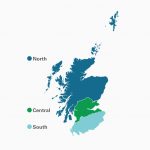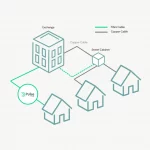Broadband and Mobile Considered as Part of UK Home Buying and Selling Reform

The UK government has begun consulting on new proposals aimed at speeding up the process of home buying and selling, while also improving the material information that Estate Agents are required to provide for every transaction. The availability of broadband, as well as mobile signal and coverage, are some of the data points proposed for inclusion in future guidance.
As above, the main focus of the government’s reform in this area (here) is on finding a way to speed up the process of buying and selling UK homes, which currently takes an average of 120 days to complete and around 1 in 3 transactions fail. As part of this, they’re also consulting on new guidance to help estate agents meet their legal obligations and improve the “material information” they provide (here).
At present quite a few estate agents already include some details, albeit often quite limited, on the broadband capabilities of the homes they list for sale. Similarly, many online property comparison websites also list such details, even if some estate agents don’t always go that far.
Advertisement
However, this detail rarely extends to include mobile signals and coverage, while alternative broadband networks can sometimes be overlooked due to limited research (i.e. there’s still a tendency to focus on only the biggest ISPs and networks).
Government Statement (Ministry of Housing)
The home buying and selling process is long, complicated and frustrating for both consumers and property professionals. A key reason for these inefficiencies is that both consumers and professionals often struggle to access the right information at the right time. Significant problems which might affect a buyer’s decision only emerge after their offer has been accepted.
We recognise that obtaining, interpreting and publishing material information can be challenging in the context of property sales. We therefore intend to produce new guidance that indicates what is likely to be considered material information, helps professionals meet their legal responsibilities and results in a better quality service for consumers.
As part of this the government have also published a list to show the categories that “we think may be considered material information“, based on previous guidance and engagement with industry stakeholders. The list mentions broadband and mobile connectivity.
Proposed Material Information for Property Sales
- price
- council tax and domestic rates
- tenure, including time remaining on lease (if applicable)
- ground rent or service charges (if applicable)
- electricity supply
- water supply
- sewerage
- heating type
- broadband
- mobile signal and coverage
- property type (for example, terraced, detached)
- number and types of room
- parking
- accessibility and adaptations
- rights and easements
- flood risk
- property construction (for example, standard, thatched roof, prefabricated)
- issues with property (for example, damp, subsidence, asbestos, Japanese knotweed)
- building safety defects, including fire and structural risk modifications
- restrictions (for example, listed property, conservation area, restrictions on usage)
- coastal erosion
- planning permission
- coalfield or mining area
- any other category
Naturally, the issue of including digital connectivity is not always an easy one to resolve, particularly in areas where copper lines with variable broadband speeds are still a factor or locations where the availability of smaller broadband networks may not always be apparent; especially if estate agents only look at data from commercial comparison sites, which often excludes the presence of smaller networks.
Extending this to include mobile connectivity can be an even bigger challenge, not least due to variability of that environment (e.g. local spectrum band assignments and cell sites do change and vary between operators) and the fact that you need to consider the importance of indoor vs outdoor reception. But Ofcom’s new Mobile Coverage Map might be able to provide a limited non-commercial basis for achieving this, even if it’s far from perfect.
Advertisement
Suffice to say it will be interesting to see what approach the government ends up taking, but we won’t learn that until later in 2026.
Mark is a professional technology writer, IT consultant and computer engineer from Dorset (England), he also founded ISPreview in 1999 and enjoys analysing the latest telecoms and broadband developments. Find me on X (Twitter), Mastodon, Facebook, BlueSky, Threads.net and Linkedin.
« Ofcom Confirm Bidders for the UK 5G Mobile Auction of 26GHz and 40GHz
Advertisement
Leave a Reply Cancel reply
Privacy Notice: Please note that news comments are anonymous, which means that we do NOT require you to enter any real personal details to post a message and display names can be almost anything you like (provided they do not contain offensive language or impersonate a real person�s legal name). By clicking to submit a post you agree to storing your entries for comment content, display name, IP and email in our database, for as long as the post remains live.
Only the submitted name and comment will be displayed in public, while the rest will be kept private (we will never share this outside of ISPreview, regardless of whether the data is real or fake). This comment system uses submitted IP, email and website address data to spot abuse and spammers. All data is transferred via an encrypted (https secure) session.





















































Working in a rural Scottish Local Authority, I have lost count of the number of times people have bought a house in a rural area, not even conceiving that full-fibre wouldn’t be available, and they get up-in-arms because they weren’t informed. Its a two-prong issue, buyer awareness and seller openness.
And Starlink for the rest of us 🙂
I suspect this requirement will be dropped.
A lot of the information can only be found through professional bodies. When last buying a property that included searches for water/sewerage connections, details of the ground (soil, radon check, pollution etc.) etc. All things that are difficult and take time for a prospective buyer to obtain.
But anyone can lookup broadband and mobile service for any property in the UK in a few seconds. It doesn’t slow the process down.
Please amend the title from “UK” to “England and Wales”. The consultation does not apply to Scotland.
From the material information consultation:
“Geographical scope
We are inviting perspectives from across the UK (England, Wales, Scotland and Northern Ireland).”
Regardless of the inputs, the underlying reforms are England and Wales only.
The process refers to making legal changes – the three UK jurisdictions (England/Wales, Scotland and NI) don’t even share basic core elements such as law societies, the use of licenced conveyors, Leasehold or land registries.
e.g. Scotland already has Home Reports and standardised sales conditions know as ‘missives’ .